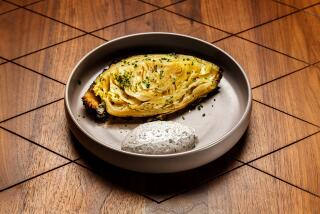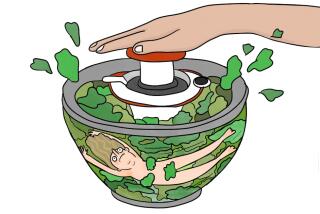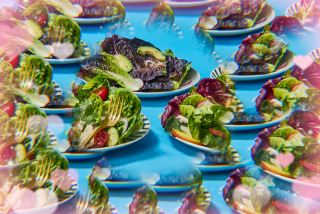Lettuce Now Raise Famous Leaves
My husband barely blinked when I told him the lettuce on his plate was an heirloom 60 years old. But then he’s not easily impressed when it comes to salads.
For one thing, he’s French, accustomed to eating mounds of greens twice a day between his meat and cheese course. His father has always tended a big kitchen garden in Normandy, where salad greens (at least) relish the near-constant drizzle.
I know the climate well. I passed my salad days there too, as a newlywed. Or you might say, as a sous-chef .
Before I was ever allowed to contribute anything more complicated to my mother-in-law’s cuisine, I was expected to prove my mettle by preparing the dinner salad. It had to be dressed with finesse. Salt and pepper, of course, just so, plus chopped shallots, tarragon, vinegar and oil.
Normally I could swing it with two parts oil to one part vinegar, but if my father-in-law had recently emptied an odd bottle of wine in the vinegar barrel, the vinegar’s pungency would be diminished, and the proportions all askew. When you work with live vinegar, you’ve got to be on your toes.
The other part of the job was cleaning the salad. It would come straight from the garden, wrapped in a week-old provincial newspaper, dripping mud, sow bugs and slugs. I won brownie points then for my lack of squeamishness, and when, eventually, I mastered the salad dressing, I was accepted as part of the family.
So it should come as no surprise that when Philippe and I finally settled in Los Angeles, lettuce was one of the first seeds I sowed. Though I was new to gardening, I couldn’t have asked for an easier subject. Salads have everything going for them. Seedlings are vigorous, impervious to transplant shock, plus they take to containers, will grow in part shade and can be tucked here and there in the garden to cover inevitable bare spots. And then, they taste so fine.
I guess that’s why lettuce has stuck around since antiquity. According to the late Waverly Root, it was cultivated in Babylonian gardens in 800 B.C., and was a favorite vegetable of the Greek and Roman era too, where it was typically served with the kind of dressing we use today. As it caught on in the Orient, in Northern Europe and America, it was flavored with herring, capers and violets (luckily, not simultaneously). Columbus supposedly introduced lettuce to our shores (now that’s something to celebrate amid the manufactured hoopla), and none other than Thomas Jefferson, a gardener’s idea of a real president, was one of its fans.
Lettuce has a history as a mild sedative, too, and wild chicory, first mentioned in the Ebers papyrus of 4000 B.C., one of the oldest Egyptian texts known, is purported to be good for diabetes, constipation, anemia and liver and skin ailments--not to mention its prescription as a cure for spring fever.
So maybe Philippe was right. What’s a 60-year-old heirloom in the scheme of things? Still, he had to admire the display of Venetian-red leaves on his plate, and once he had a taste of the buttery flesh, he agreed I should keep growing it. Forever.
In Southern California you can grow salad lettuces nine months of the year (near the coast, year-round). They prefer the cool conditions of late fall and early spring though, so there are a few tricks to sowing them right now. Most important: choose fast-maturing, heat-tolerant varieties of lettuce such as Buttercrunch, Salad Bowl, Tom Thumb, Little Gem and Summer Bibb. Sow the seed in an area with afternoon shade and, as the seedlings mature, keep them well watered and mulched. On hot days you’ll need to cover them with shade cloth, too, but it’s a small effort for such a reward.
In as little as 45 days, you can start harvesting the outer leaves (thinnings even earlier). Or, if you prefer, wait a little longer and lop off the whole lettuce, leaving behind an inch of stem to produce a second crop.
I’m warning you, these things are addictive. Soon you’ll want to try all sorts of what we commonly call salads: four varieties of Lactuca sativa (two heading types: crisphead and butterhead; plus loose-leaf and romaine/cos), and four varieties of Cichorium endivia (curly-leaf, radicchio-leaf and Catalogna-leaf chicories, plus escarole/batavia, or broad-leaf chicory). If you get your seed from nursery racks, you won’t have a lot of choice. But these classifications might come in handy if you take the plunge and join the Seed Savers Exchange, whose 1992 catalogue lists 429 varieties of salads.
That’s right: 429 varieties, with names like Deer Tongue and Tennis Ball (grown by Thomas Jefferson in 1809). And those are just the varieties grown by Americans. Europeans have an appetite for heirloom lettuce, too. In fact, they’re such salad lovers, there’s reportedly even a self-serve restaurant in Germany where customers choose among rows of different salads, and portions are priced by the kilo.
Wouldn’t I love to dip into those European heirloom lists. But my plate is already full.
This year, aside from such other greens as arugula, mache, nasturtium leaves and sorrel, I’ve squeezed into my garden Continuity, Buttercrunch, Black-Seeded Simpson and Full Heart escarole.
Yet here’s one sentimental favorite that’ll always find a place in my back yard: a flavorful chicory I’ve let self-sow for years. This salad’s not for everyone. Its texture is, well, chewy, and its bitterness pronounced. In fact, it’s so very bitter we combine it with other greens in a mesclun , or add sweet sun-dried tomatoes to its dressing for balance. Other times we’ll just chop it up, and throw it in a pot for a home-grown version of escarole soup.
This lettuce runs wild. I’ve seen it in Montana and along Italian roadsides. I have no idea how it got into my garden. Maybe it hitched a ride on the back of that possum that haunts the neighborhood. I’m pretty sure now, though, after researching this article, that my back yard chicory, with its showy blue flowers that close in early afternoon, is what the American pioneers called Blue Sailors and what the French still cultivate for the manufacture of “coffee chicory” and for the fancy blanched salad called Belgian endive.
Which makes my Blue Sailors the very same chicory, Cichorium Intybus, mentioned in that Ebers papyrus. Which means Philippe’s and my dinner salad is nearly 6,000 years old.
Exotic lettuce seeds are available from Nichols Garden Nursery, 1190 N. Pacific Highway, Albany, Ore. 97321-4598.
For more information, write the Seed Saver’s Exchange at Rural Route 3, Box 239, Decorah, Iowa 52101.
More to Read
Eat your way across L.A.
Get our weekly Tasting Notes newsletter for reviews, news and more.
You may occasionally receive promotional content from the Los Angeles Times.










